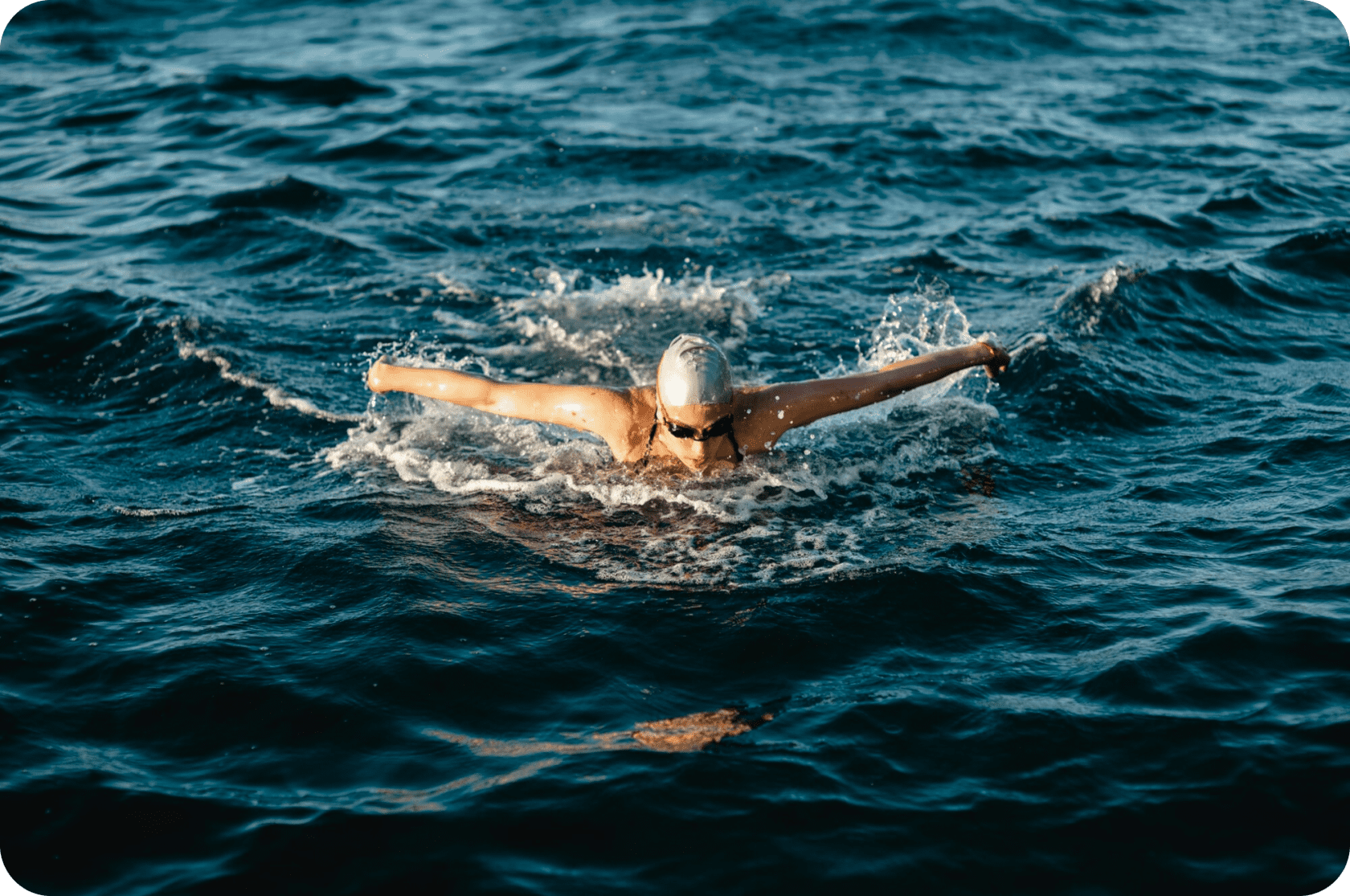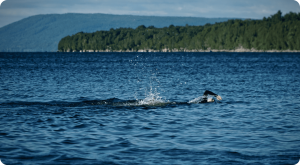In triathlon training, swimming one mile is super important. This is not just a random distance to swim — it’s a big deal.
When you nail this distance, it helps you get way better at swimming, boosts your confidence, and gets you ready for races.
Once you’ve got this down, you’ve got a solid base to improve your swimming skills, get better at going the distance, and toughen up mentally for open water races.
So, put your goggles on, get ready to jump in, and conquer that one-mile swim.
Evaluate Your Swimming Skills and Aerobic Capability
Before embarking on a one-mile odyssey, it’s important to conduct a self-assessment of your current swimming skills.
This will allow you to identify your strengths and weaknesses and chart a course for optimal training.
1. Comfort Level
Can you swim continuously for 20 minutes without significant discomfort or fatigue? How confident are you navigating in open water?
To train your comfort level, you should gradually enter deeper water, swim with a partner, and do exercises that focus on body position and buoyancy.
2. Technique
Look closely at different parts of your swimming technique: How’s your body position, head position, breathing, arm movement, and kicking?
Good technique helps you use less energy and avoid injuries.
If you notice any problems, there are drills to fix them, like keeping your head up or improving your kick.
3. Endurance
Want to see how long you can swim? Try timing yourself or doing interval training in a pool.
To get better, try swimming farther little by little, mix up fast and slow swimming, focus on breathing right, and use the best technique.
Remember, how well you last in the water depends on how often you train, what you eat and drink, and how well you sleep.
4. Mental Grit
Long-distance swims can be mentally draining. You might feel scared, bored, tired, or even unsure you can finish the total distance.
To stay strong mentally, try imagining yourself succeeding and staying motivated.
Use positive thoughts to keep going, like telling yourself you can do it one lap at a time or focusing on your breathing.
5. Consulting a Doctor
If you’ve got health issues like heart problems or asthma or had recent surgeries, it’s a good idea to check with a doctor before training hard.
Always pay attention to how your body feels. If something hurts or doesn’t feel right, get help from a pro.
Being honest about where you’re at and what you need to work on is the first step to getting better. There’s no shame in finding areas to improve — it’s how you get stronger.

6 Easy Steps to Your Perfect One Mile Swim
In the endless embrace of water lies the swimming 1 mile, a challenging yet exciting test of your swimming skills.
But overcoming this distance doesn’t require superhuman effort, just smart planning and consistent training.
Follow these 6 simple steps to create your personalized plan for the ultimate endurance swim.
Step 1. Assess Your Base
Before plotting your journey, know your starting point.
Take a timed 400-meter swim, half the target distance. If 400 meters feels daunting, start with the common length you’re comfortable with and gradually increase it over time.
You can also test your time for shorter distances (e.g., 100 meters) and extrapolate to estimate your longer-distance pace.
Consider including different swim styles (e.g., freestyle, backstroke) to understand your strengths and weaknesses across different techniques. Note your pace, comfort level, and areas for improvement.
This is your baseline, your launchpad for progress. Additionally, evaluate your comfort in deeper water and open-water environments.
If needed, practice treading water and gradual submersion to build confidence.

Step 2. Set Achievable Miles
Swimming the mile might seem like a vast, monolithic challenge, especially in cold water. But it’s not an unclimbable mountain.
Instead of staring at the daunting peak, set clear, attainable markers along the ascent.
Think of it as a series of rolling hills, each one achievable and a stepping stone to the summit.
This is where step 2 comes in: setting an achievable swim for a mile to divide and conquer the distance.
Here are a few tips to help you complete this distance:
1. Don’t try to walk half a swimming mile on your first time.
Start with smaller steps, for example, cover 200 meters in a certain time. This will give you confidence and make it easy to assess your progress.
2. Set your goals consistently, gradually increasing the distance and target time as you get stronger.
Aim for attainable increments, perhaps adding 100 meters or 30 seconds to your previous record every week or two.
3. Remember to underestimate the power of small victories.
Each swimming one mile you reach is a mini-triumph, a testament to your dedication and progress. Take the time to celebrate these accomplishments, even if they seem insignificant compared to the end goal.
Be realistic – setting goals that are too ambitious can lead to frustration and burnout.
Analyze your baseline from step one and set intermediate goals that stretch you but are still achievable based on your current ability and training frequency.
Also, don’t just focus on distance. Incorporate time goals into your intermediate goals to track your pace improvement and make sure you’re developing both endurance and speed.
Check out this intermediate triathlon training plan to learn more about how it differs from beginner and advanced training routines.
Step 3. Refine Your Stroke
Brutal force won’t win this race. Instead, focus on smooth, efficient strokes that minimize energy expenditure and maximize propulsion. Analyze your body alignment, breathing pattern, and kick.
Are you slicing through the water like a dolphin or dragging an anchor?
Practice targeted drills to address any technical flaws.
A strong kick from your core, controlled breathing for oxygenation, and a streamlined body position are your allies in conquering the mile.
Consider seeking expert guidance from a coach or swim clinic for personalized technique analysis and training plans. If you haven’t found a coach yet, here are some tips on how to choose the best triathlon coach.
Let’s take a look at the improvements to the stroke mechanics.

Stroke Mechanics Refinement
1. Body Position
Emphasize maintaining a horizontal body position in the water to reduce drag.
Ensure your body is aligned, with your head in a neutral position, looking straight down.
2. Arm Movement
Focus on an efficient and powerful arm stroke. Initiate the stroke by extending your arm forward, then pull it underwater in a fluid motion.
Optimize hand placement, pull, and push phases for maximum propulsion.
3. Kicking Technique
Coordinate your kicking with your arm strokes to maintain balance and propulsion.
Work on a steady flutter kick or experiment with other kicking styles to find what works best for you.
Ensure your kicks are continuous and not excessively splashy.
Improving swimming technique takes time and consistent practice.
Be patient with yourself and stay dedicated to consistently working on refining your stroke mechanics, breathing, and body positioning.
Incremental improvements will accumulate over time, leading to better efficiency and endurance in your swimming.
Step 4. Embrace Interval Training
Think of interval training as building your swimming engine with high-octane bursts and refueling pit stops.
You alternate periods of high-intensity swimming (the most common length is around 50 meters) with recovery periods (cruising laps at a comfortable pace).
This pushes your body to adapt, boosting your speed and stamina simultaneously.
1. Start Small
Begin with distances you can easily handle, like 200 meters.
As you get stronger, add increments, maybe 100 meters or 5 minutes per workout. Don’t rush. Let your body adapt and enjoy the feeling of swimming further.
2. Break It Down
Don’t stare at the entire swimming the mile with trepidation.
Divide your distance builds into smaller sets, maybe completing four 250-meter laps instead of one continuous mile.
This makes the distance feel less daunting and allows you to track your progress more effectively.
3. Find Your Rhythm
As you swim longer distances, experiment with different pacing strategies.
You can maintain a steady tempo throughout, try a faster-slower-faster approach, or even incorporate interval training within your longer swims.
Find what works best for you and keeps you comfortable and motivated.
Remember, building sustainable endurance isn’t about pushing yourself to the brink every workout.
It’s about consistent, gradual progress, listening to your body, and enjoying the journey.
With each conquered interval and extended distance, you’ll feel your engine grow stronger, preparing you to power through the mile swimming with confidence and ease.

Step 5. Strengthening and Flexibility Exercises
Supplement your swim training with exercises that enhance strength and flexibility.
Target each muscle group used in swimming through dryland workouts, focusing on core strength, shoulder stability, and leg muscles.
Incorporate stretching routines to improve flexibility, aiding in a wider range of motion and reducing the risk of injuries during training and the actual swim.
Step 6. Patience and Consistency
Improving swimming technique takes time and consistent practice.
Be patient with yourself and stay dedicated to consistently working on refining your stroke mechanics, breathing, and body positioning.
Incremental improvements will accumulate over time, leading to better efficiency and endurance in your swimming.
Your progress may not be linear at this point, but in like six weeks from now you will see how far you’ve come.
1. Practice, Practice, Practice
Think of consistent practice as your daily dose of magic potion.
Each session, even if it’s just for a short time, adds a drop of strength, endurance, and skill to your swimming cauldron.
Don’t get discouraged by setbacks; view them as stepping stones and moments to analyze and adjust your technique.
Consistency, not perfection, is the key.
2. Focus on Incremental Gains
Don’t expect to transform into an Olympic champion overnight. Aim for small, achievable improvements each workout.
Shave a few seconds off your lap time, add 10 meters to your distance, or perfect that breathing technique you’ve been practicing.
These incremental gains, like seeds sprouting into sturdy trees, will gradually manifest into significant progress over time.
3. Seek Inspiration, Not Comparison
Find motivation in the stories of other swimmers, their struggles, and triumphs.
But remember, their journey is theirs; yours is unique. Avoid the trap of comparison, which can demotivate and derail your progress.
Conclusions
The mile is not just a distance; it’s a metaphor for overcoming self-doubt, pushing boundaries, and discovering the depths of your resilience.
So, dive in, embrace the journey, and let the water become your canvas, each stroke a brushstroke painting your triumph.
Remember, perfect swimming isn’t about achieving flawless form or breaking impossible records.
It’s about conquering your personal Everest, rising above your expectations, and experiencing the exhilaration of a challenge met head-on with unwavering determination.
Pay attention to these tips as well:
Build up gradually
Start by swimming shorter distances and gradually increase your distance each week. This helps your body get used to swimming longer distances without getting too tired or risking injury.
Mix up your training
Include a variety of workouts in your training plan, such as interval training, endurance swims, and technique drills. This keeps your workouts interesting and helps you improve different aspects of your swimming, like speed, stamina, and form.
Focus on technique
Work on improving your swimming technique to swim more efficiently and reduce fatigue. Practice drills that target specific aspects of your technique, such as body position, breathing, and arm stroke.
Include a rest day
Make sure to include rest days in your training plan to give your body time to recover and prevent overtraining. Rest is just as important as training, as it allows your muscles to repair and rebuild stronger.
Stay consistent
Consistency is key when training for a mile swim.
Stick to your training plan and make swimming a regular part of your routine. Even on days when you don’t feel like swimming, try to get in the pool and do at least a short workout to keep up your momentum.
By taking the time to assess your base, you’ll be in a much better position to set achievable goals and design an effective training plan for your one-mile swim.
Trust the process, have fun, enjoy the journey, and watch your swimming prowess flourish!





